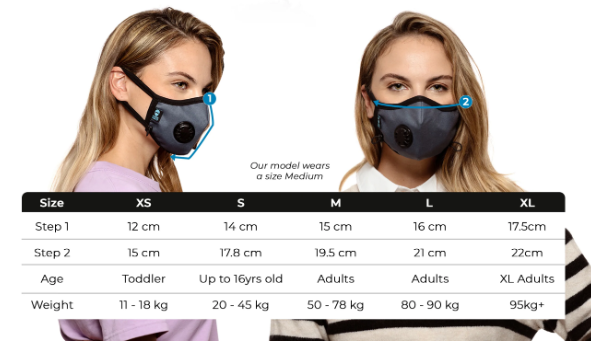Size Guide & Mask Usage Information
This article covers the following topics:
- Sizing Guide
- Washing Guide
- Storage Guide
- Infant Mask - Extra Small
- How do the valves work?
- Beards
- Glasses
- Motorcycle/Cycle
- Running
Sizing Guide
To make sure that the mask is the right size for you, please follow these steps:
- Measure from the middle of your nose to just over an inch below your chin. This measurement corresponds to the first number on our size chart.
- For the second measurement, measure the width of your face from the outer edge of your left cheekbone to the outer edge of your right cheekbone, about an inch below your temples. Add a couple of millimeters to this measurement to ensure the mask isn't too small.
When you wear the mask, check for any gaps between the mask and your face while inhaling. If the mask pulls your ears forward or rises above your chin, it may be too small. Our size recommendations are also based on body weight for further accuracy.
https://cambridgemask.com/pages/size-chart

Washing Guide
Cambridge Masks are washable, but please note that washing only cleans the outside surfaces of the mask and does not remove the pollution trapped inside the filter. To ensure proper filtration, the mask should be replaced after extended use.
Washing instructions can be found on the back of the mask box. To wash the mask, gently massage it in warm water mixed with washing soda. This will remove dirt, makeup, and dust, but it will not extend the life of the filters. After washing, hang the mask to dry.
https://cambridgemask.com/blog/washable-masks/
Storage Guide
Our PRO and Non-valve masks come in eco-friendly packaging, including reusable plastic zip-lock bags that serve as a safe storage compartment for your mask when not in use.
Ensure the mask is completely dry before storing it, especially in warm environments.
Infant Mask - Extra Small
We do not offer masks for babies under 1.5 years due to choking risks and because their lungs cannot overcome the resistance required to inhale properly through our filter materials. From 1.5 years onward, healthy children should be able to breathe through the mask without limiting their oxygen intake. Depending on the circumstances, using a mask at this age can be beneficial to protect young children from high levels of pollution. Children should only wear respirators when under close adult supervision and only when necessary.
Our extra small (XS) size masks are specifically designed for toddlers and very small children. The adjustable features, such as toggles and nose clips, are too large for these masks, so we do not include them. Additionally, the XS size does not come with a valve for the same reason. This typically does not cause issues, as smaller children do not need to exhale as much air as adults.
How do the valves work?
The valve operates by opening when you exhale and closing when you inhale. You can observe this process by looking in a mirror to see it in action.
We have improved the functionality of the valve by adjusting the thickness of the inner membrane, ensuring it opens and closes precisely with each breath.
Beards
Please note that most health and safety organizations advise against having facial hair when using a mask, as it can affect the seal and fit. Although some customers with beards have reported positive experiences, we cannot formally recommend it.
A thick beard can make it challenging to achieve a proper seal, but the ribbing of the mask is designed to fit closely to the skin. If you are near the upper limit of our sizing guidelines, you might consider ordering a size up.
Glasses
Sunglasses and glasses may fog up if the mask is slightly too large, allowing air to escape through the top when you exhale.
To address this, try adjusting the nose clip and slightly altering the straps, as these are the primary methods for ensuring a better fit. Some customers have also found that using our Head strap helps tighten the fit. Additionally, we have developed a Nose foam that can be attached to the mask's nose clip. The Head strap and Nose foam set comes with your PRO and Non-valve masks or can be purchased separately on our website.
https://cambridgemask.com/blog/mask-fogging/
Motorcycle/Cycle
It can be problematic when wearing a motorcycle helmet over a Cambridge Mask. Currently, there is no PPE on the market that comfortably fits under a helmet. This leaves options like "buff" type bandanas, which offer minimal protection against pollution. While you might find one that claims to filter PM2.5, we strongly recommend verifying the manufacturer's claims.
Given the nature of filters required for effective PM2.5 filtration, it's unlikely that a simple bandana-type mask will provide adequate protection. Anything made solely of cotton without an integrated filter is unlikely to shield you from pollution effectively.
Rest assured, we are continually working to improve our masks and develop new products that are better suited for various activities.
Running
The mask should fit snugly on your face, ensuring it is not too tight to restrict movement and not too loose to allow air to seep in through gaps. The valve quickly expels exhaled air, while it closes during inhalation, forcing the air through the filters. Initially, you might feel slight resistance, but this sensation should become largely unnoticeable as you get used to wearing the mask.
If you have further questions, please contact us by email at info@cambridgemask.com or Chat button on our sites to connect with our Customer Service Team.
